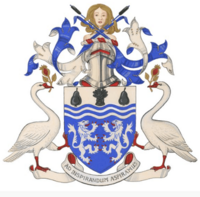University of Worcester facts for kids

Coat of Arms
University of Worcester |
|
| Motto |
Latin: Ad Inspirandum Aspiramus
|
|---|---|
|
Motto in English
|
Aspire to Inspire |
| Type | Public |
| Established | 1946 – Worcester Emergency Teacher Training College 1948 – Worcester Teacher Training College 1976 – Worcester College of Higher Education 1997 – University College Worcester (Given degree awarding powers) 2005 – University Status |
| Chancellor | Prince Richard, Duke of Gloucester |
| Vice-Chancellor | David Green |
|
Academic staff
|
300 |
|
Administrative staff
|
700 |
| Students | (2015/16) |
| Undergraduates | (2015/16) |
| Postgraduates | (2015/16) |
| Up to 30 at any time | |
| Location |
Worcester, England, UK
52°11′53″N 02°14′37″W / 52.19806°N 2.24361°W |
| Campus | Urban |
| Colours | Blue and White |
 |
|
The University of Worcester is a public university located in Worcester, England. It's a place where students learn and do research. The university started a long time ago in 1946. It began giving out degrees in 1997 and officially became a full university in 2005.
Contents
History of the University

In 1946, a special college was set up in Worcester to train teachers. It was built on an old RAF base from World War II. Henry Hines was the first principal, followed by E.G. Peirson in 1951. During Mr. Peirson's time, the college started offering degrees.
Later, David Shadbolt became principal in 1978. He organized the college into three main areas: Education, Arts, and Sciences. In 1992, Dorma Urwin took over, and Coventry University helped approve the college's degree courses.
In 1997, the college was allowed to give out its own degrees. It then became known as University College Worcester. In 2003, David Green became the new leader. In 2005, the college officially became the "University of Worcester."
The university continued to grow. In 2010, it gained the power to award research degrees like PhDs. That same year, the university opened its City Campus. This new campus was in a renovated old hospital building. In 2012, the university opened The Hive. This was a huge £60 million building for learning and studying. Queen Elizabeth II officially opened it.
In 2021, the university decided to close its archaeology department. This change happened at the end of the 2021/22 school year.
University Locations and Campuses
Since 2005, the University of Worcester has grown a lot. It has added many new sites around the city. The university plans to keep building new places for both students and the community.
St John's Campus: The Main Hub
The main campus is called St John's. Most courses and support services are based here. It has student housing with over 872 rooms. There's also a sports center and sports fields.
The campus has special facilities for training nurses and other health workers. It also has a modern digital arts center. The Peirson Centre offers study spaces and computer facilities. This campus is near the local area of St John's, Worcester.
City Campus: Home of Business Studies
The university's second campus is called City Campus. This is where the Worcester Business School is located. It opened in September 2010. The campus is on the site of the old Worcester Royal Infirmary hospital.
The original hospital buildings were designed by a famous architect named Anthony Keck. Work on the campus started in 2007. New student housing for 250 students was also built here. The Art House is another building on City Campus. It used to be a warehouse and is now home to the School of Arts. This building is very eco-friendly, earning a Gold standard for being green.
The old Jenny Lind Chapel has been restored. The room where the British Medical Association started in 1832 has also been refurbished. An exhibition called The Infirmary opened in 2012. It tells the history of the old hospital building.
Riverside and Worcester Arena: Sports and Events
The university also has a large area next to the River Severn called "Riverside." This area includes an Art Space and Exhibition building. There is also a large sports arena that can hold 2,000 people.
This arena is used for sports and events. It is the home of the Worcester Wolves basketball team. It's also a special center for disability sports. The Worcester Arena is open for the local community to use as well.
Lakeside Campus: Outdoor Adventures
Lakeside Campus is in the countryside of Worcestershire. It's only a 10-minute drive from the main campus. This 50-acre site has a lake for watersports. It also has grass fields, woodlands, and an activity center.
The Hive is a special project between the University of Worcester and Worcestershire County Council. The Queen officially opened it in July 2012. It's next to the City Campus in the center of Worcester.
The Hive brings many services together in one building. It has a library for both the public and the university. It also holds the Worcestershire Archive and Record Office. The Hive has over 250,000 books and 12 miles of archive collections. It also has meeting rooms, exhibition spaces, and a theater. There are many study areas and over 500 computers for students and visitors.
University Park: Future Growth
The university plans to build a third campus called University Park. This will be on a 47-acre piece of land about 1 mile from St John's campus. This new site will take about fifteen years to complete. It will include areas for business, science, and sports. It will also help the university expand its work in healthcare.
Other University Spots
The university also owns other halls and sports facilities around Worcester. These are smaller locations compared to the main campuses.
The university was chosen as an official training camp for the London 2012 Olympic and Paralympic Games. This meant international sports teams could train there before the games.
Caring for the Environment
The University of Worcester is committed to being environmentally friendly. It was the first university in England to receive a Gold EcoCampus Award. This award recognizes its efforts to be green. The university has also been recognized for its low carbon footprint.
How the University is Organized
On April 10, 2008, The Duke of Gloucester became the first chancellor of the university. He attends graduation ceremonies and other important events. He also helps promote the university around the world.
The university has a group called the College of Fellows. These are important "ambassadors" for the university. New Fellows are chosen each year at graduation ceremonies. The university is run by a board of governors. There is also an executive management board that makes weekly decisions.
The university has different academic schools. These include:
- School of Allied Health & Community
- School of the Arts
- School of Education
- School of Humanities
- School of Nursing & Midwifery
- School of Psychology
- School of Science & the Environment
- School of Sport & Exercise Science
- Worcester Business School
- University of Worcester International College
Academic Achievements
University Reputation and Rankings
| National rankings | |
|---|---|
| Complete (2021) | 88= |
| Guardian (2021) | 112 |
| Times / Sunday Times (2021) | 99 |
| Global rankings | |
| THE (2021) | 1201–1500 |
| British Government assessment | |
| Teaching Excellence Framework | Silver |
An Ofsted report rated the university's teacher training program as "Excellent." In June 2010, it was even rated "Outstanding." Student surveys have also shown that students are very happy with the university. In 2008, Worcester was in the top 40 universities for student satisfaction. Students studying English, History, and Teacher Training were especially satisfied.
In March 2010, the university was ranked 54th among the best public sector places to work.
University Research
In August 2010, the university was allowed to award its own research degrees. This means students can earn advanced degrees like MPhil and PhD there. The university has several national research centers, including:
- The National Pollen and Aerobiology Research Unit: This unit provides all UK national pollen forecasts. It also tests new products for hay fever and allergies.
- The Centre for Rural Research: This center studies how events like floods affect people in the countryside.
- The International Centre for Children's Literature, Literacy and Creativity: This is one of only three UK university centers with full-time professors who study children's literature.
- The Motion Performance Centre: This center studies sports injuries and how to help people recover. It uses special motion capture technology.
- The Association for Dementia Studies: This center, launched in 2010, focuses on understanding and helping people with dementia.
Student Life at Worcester
The Worcester Students' Union is the group that represents students at the university. It is located in a building on the St John's Campus. The union offers many services and facilities for students. It is led by elected student officers. The official student newspaper is called The Voice.
Sports Activities
The university is home to the Worcester Wolves basketball team. It also has the Worcester Allstars Football team and the Worcester Royals, an American Football team. Some students at the university are even England Blind Footballers.
The university also works with the local Premier 15s rugby team, Worcester Warriors Women. As part of this partnership, the team is now called 'University of Worcester Warriors'.
Famous People Who Studied Here
Many notable people have studied at the University of Worcester. Some of them include:
- Waqar Azmi OBE, a diplomat and former chief adviser to the prime minister.
- Pat Brown, a cricketer.
- Sophie Carrigill, a paralympian athlete.
- Matthew Hudson-Smith, an Olympic athlete.
- Daryl Mitchell, a cricketer.
- Kyle Pryor, an actor.
- Swaroop Sampat, an actress and former Femina Miss India.
- Jacqui Smith, a politician.
- Imogen Thomas, a model.
See also
 In Spanish: Universidad de Worcester para niños
In Spanish: Universidad de Worcester para niños
- Armorial of UK universities
- College of Education
- List of universities in the UK

